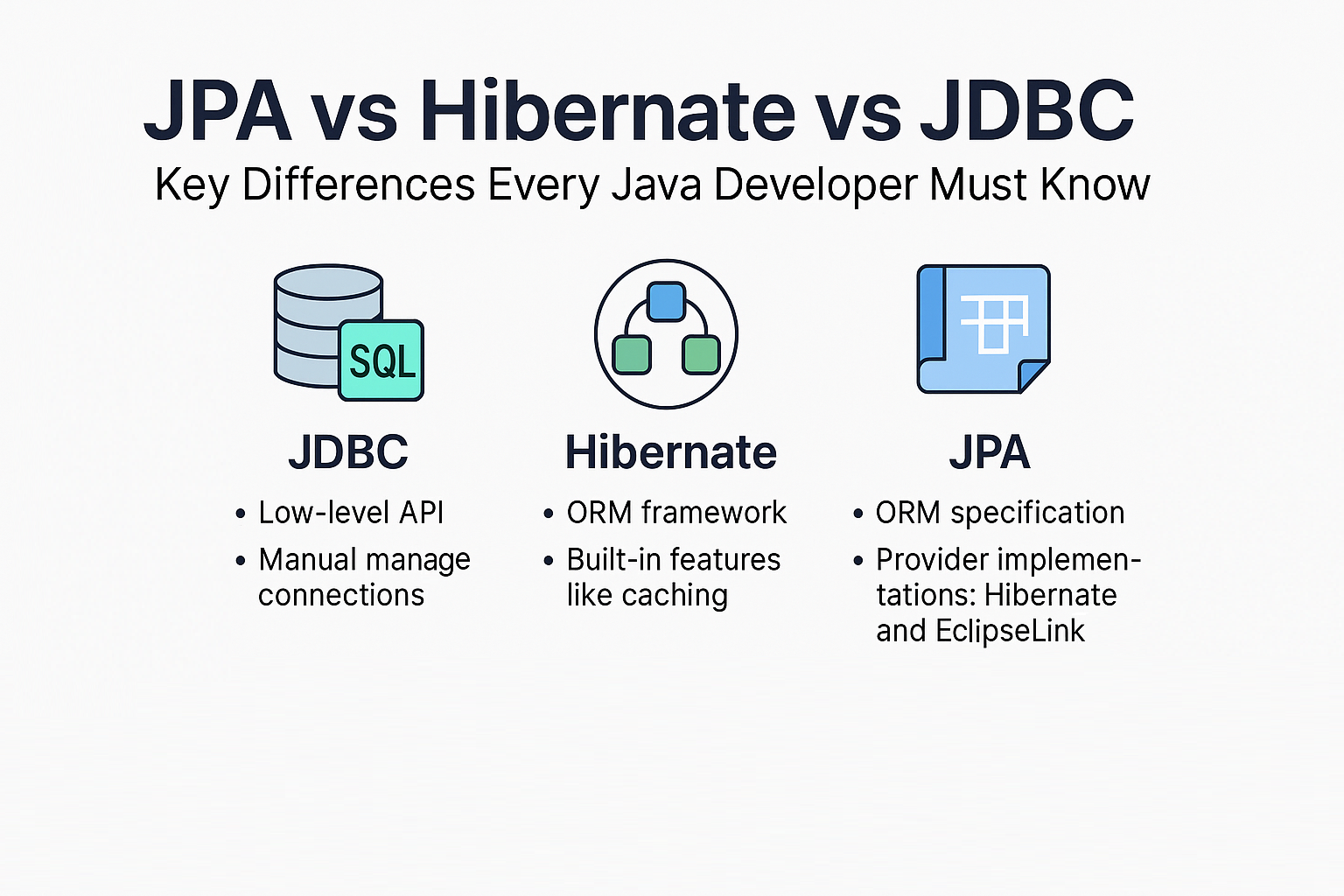Database interaction is one of the most critical aspects of Java development. Over the years, Java developers have relied on JDBC, Hibernate, and JPA for this purpose. While these terms are often used interchangeably, they represent different layers of abstraction and serve different roles.
In this tutorial, we will break down JPA vs Hibernate vs JDBC, compare them with real-world examples, and explore when to use each approach.
What is JDBC?
- JDBC (Java Database Connectivity) is the lowest-level API for interacting with relational databases in Java.
- It provides direct access to SQL execution and result handling.
- Developers must manage connections, statements, and result sets manually.
Example: JDBC Insert
Connection conn = DriverManager.getConnection("jdbc:h2:mem:testdb", "sa", "");
PreparedStatement ps = conn.prepareStatement("INSERT INTO users (name, email) VALUES (?, ?)");
ps.setString(1, "Alice");
ps.setString(2, "alice@example.com");
ps.executeUpdate();
ps.close();
conn.close();
Pros:
- Full control over SQL.
- High performance if optimized.
Cons:
- Lots of boilerplate code.
- Manual transaction and resource management.
- Tight coupling to database-specific SQL.
What is Hibernate?
- Hibernate is an ORM (Object Relational Mapping) framework that automates SQL generation and object-to-table mapping.
- It is the most popular JPA provider, but it can also work outside JPA.
Example: Hibernate Entity
@Entity
@Table(name = "users")
public class User {
@Id
@GeneratedValue(strategy = GenerationType.IDENTITY)
private Long id;
private String name;
private String email;
}
Example: Hibernate Session CRUD
SessionFactory factory = new Configuration().configure().buildSessionFactory();
Session session = factory.openSession();
Transaction tx = session.beginTransaction();
User user = new User();
user.setName("Alice");
user.setEmail("alice@example.com");
session.save(user);
tx.commit();
session.close();
Pros:
- Eliminates boilerplate JDBC code.
- Rich ORM features: caching, lazy loading, criteria queries.
- Database independence.
Cons:
- Learning curve.
- Overhead compared to raw JDBC for simple queries.
What is JPA?
- JPA (Java Persistence API) is a specification, not a framework.
- It defines the standard for ORM in Java.
- Hibernate, EclipseLink, and OpenJPA are JPA implementations.
Analogy:
JPA is like the blueprint, Hibernate is the building contractor, and JDBC is the raw bricks and cement.
Example: JPA EntityManager CRUD
EntityManagerFactory emf = Persistence.createEntityManagerFactory("examplePU");
EntityManager em = emf.createEntityManager();
em.getTransaction().begin();
User user = new User();
user.setName("Alice");
user.setEmail("alice@example.com");
em.persist(user);
em.getTransaction().commit();
User found = em.find(User.class, 1L);
em.close();
emf.close();
Core Differences: JPA vs Hibernate vs JDBC
| Feature | JDBC | Hibernate | JPA |
|---|---|---|---|
| Type | Low-level API | ORM Framework | ORM Specification |
| Control | Full SQL control | Automates SQL + ORM | Defines rules; provider implements ORM |
| Boilerplate | High | Medium | Low |
| Portability | Database-specific SQL | Database-independent | High portability across providers |
| Learning Curve | Low | Medium | Medium |
| Performance | High if optimized manually | Good with caching and fetching strategies | Depends on provider implementation |
| Use Case | Simple queries, analytics-heavy | Enterprise ORM, caching, relationships | Standardized ORM across frameworks |
JPA Persistence Context
Think of Persistence Context as a classroom attendance register. Once an entity is inside, the teacher (EntityManager) knows its state and keeps it updated with the database.
em.getTransaction().begin();
User user = em.find(User.class, 1L); // Managed entity
user.setName("Updated Alice"); // Auto-synced with DB
em.getTransaction().commit();
Querying Approaches
JDBC Query
ResultSet rs = conn.createStatement().executeQuery("SELECT * FROM users");
while (rs.next()) {
System.out.println(rs.getString("name"));
}
Hibernate HQL
List<User> users = session.createQuery("FROM User WHERE name = :name", User.class)
.setParameter("name", "Alice")
.getResultList();
JPA JPQL
List<User> users = em.createQuery("SELECT u FROM User u WHERE u.name = :name", User.class)
.setParameter("name", "Alice")
.getResultList();
Performance Considerations
- JDBC: Best for raw SQL performance; no ORM overhead.
- Hibernate: Can face N+1 query problem if not optimized. Use
JOIN FETCH. - JPA: Performance depends on the chosen provider (e.g., Hibernate).
Lazy vs Eager Loading Analogy:
Lazy loading is like ordering food only when hungry; eager loading is like ordering the entire menu upfront.
Real-World Use Cases
- JDBC: Analytics systems, ETL jobs, batch processing.
- Hibernate: Enterprise systems with complex relationships.
- JPA: Enterprise portability (Spring Boot, Jakarta EE).
Anti-Patterns and Pitfalls
- Using eager fetching everywhere → performance bottlenecks.
- Overusing cascade remove → unintended data loss.
- Ignoring transaction boundaries → inconsistent state.
Best Practices
- Prefer lazy fetching.
- Use DTOs for read-heavy queries.
- Log SQL with
hibernate.show_sqlfor debugging. - Profile queries with tools like JPA Buddy or Hibernate Stats.
📌 JPA Version Notes
- JPA 2.0: Introduced Criteria API, Metamodel.
- JPA 2.1: Added stored procedures, entity graphs.
- Jakarta Persistence (EE 9/10/11): Migration from
javax.persistence→jakarta.persistence.
Conclusion and Key Takeaways
- JDBC: Best for full SQL control and batch processing.
- Hibernate: Powerful ORM framework with advanced features.
- JPA: Standard that unifies ORM and ensures portability.
Choose based on your project needs: raw performance (JDBC), advanced ORM (Hibernate), or standardized abstraction (JPA).
FAQ
1. What’s the difference between JPA and Hibernate?
JPA is a specification, Hibernate is an implementation.
2. How does JPA handle persistence context?
It tracks entities like a register, auto-syncing with the DB.
3. What are drawbacks of eager fetching?
Unnecessary data loads → memory and performance issues.
4. How can I solve N+1 select problem?
Use JOIN FETCH or entity graphs.
5. Can I use JPA without Hibernate?
Yes, e.g., with EclipseLink or OpenJPA.
6. What’s the best inheritance mapping strategy?
Depends: SINGLE_TABLE (fast), JOINED (normalized).
7. How does JPA handle composite keys?
Using @IdClass or @EmbeddedId.
8. What changes with Jakarta Persistence?
Namespace changed from javax.persistence → jakarta.persistence.
9. Is JPA suitable for microservices?
Yes, but avoid long transactions; use DTOs.
10. When should I avoid JPA?
Analytics-heavy, high-throughput systems needing custom SQL.
